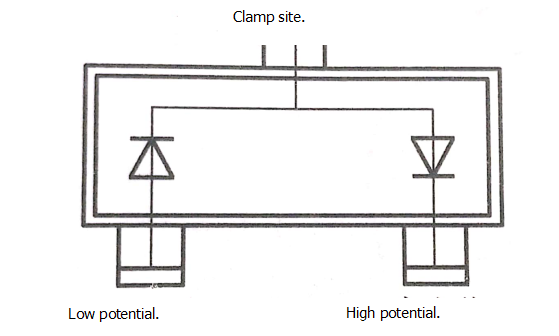What is the clamp position of the diode?
The clamp function of the diode is also called amplitude limiting, that is, limiting the amplitude of the signal. In short, it is a kind of restriction on the signal. The question is, what need to limit? Of course is the voltage of the signal. In other words, we can limit the voltage of a signal through a diode: if we do not want the voltage of the signal to be greater than a certain maximum, we can also use diode clamp to achieve it, and if we do not want the voltage of the signal to be less than a minimum, we can also use diode clamp.
We need to limit both the maximum and minimum values of the signal, as shown in figure 1.

Figure 1 limits the maximum and minimum values of the signal
We first connect the signal to the "clamped point", then connect the "high potential" to a power supply equal to the maximum voltage value of the signal, and finally connect the "low potential" to a power supply equal to the minimum voltage value of the signal (or ground). Then we analyze the conduction and cutoff of the two diodes when the voltage of the signal changes, and their influence on the current level of the clamped point.
Let's assume that at some point, the level of the "clamp point" is higher than the "high potential" and is high enough to make the diode on the right side, when the diode is turned on because its "positive voltage is greater than the negative voltage, and the voltage of the" clamp point "loses the power to continue to rise because of the drain effect of the clamp tube. Isn't that what limits the maximum voltage of the signal?
Let's assume that at some point, the level of the "clamp point" is lower than the "low potential" and is low enough to turn on the positive voltage of the diode on the left side, and the voltage of the "clamp point" will be turned on because its positive voltage is greater than the negative voltage, and the voltage of the "clamp point" will have the power to continue to rise because of the replenishment of the clamp diode. Doesn't that limit the minimum voltage of the signal?
In short, the limiting effect of the diode is worthy of the name, and the circuit structure does make the level of the "clamped point" always within the amplitude larger than the "low potential" and less than the "high potential".
In a broad sense, the circuit behavior that the collector potential is pulled down to the ground after the emitter grounding NPN transistor is turned on, and the circuit behavior that the drain potential is pulled down to the ground after the source grounding N channel field tube is turned on can be understood as clamps.
If you want to know more, our website has product specifications for the diode, you can go to ALLICDATA ELECTRONICS LIMITED to get more information

